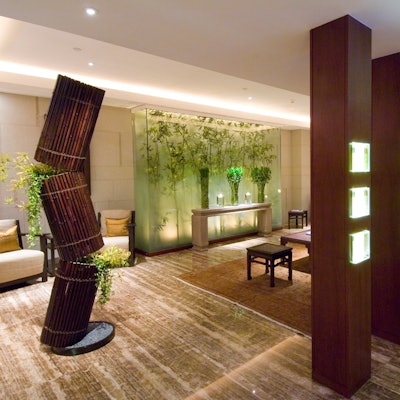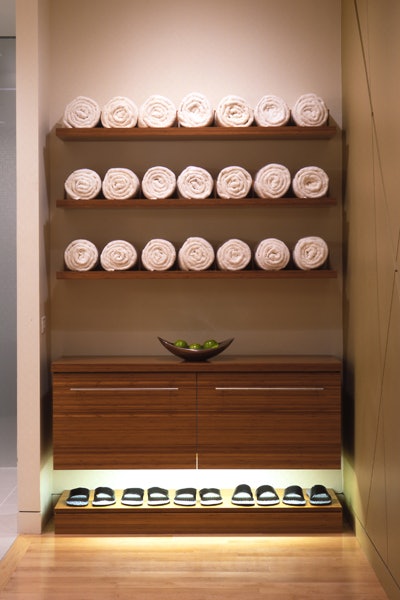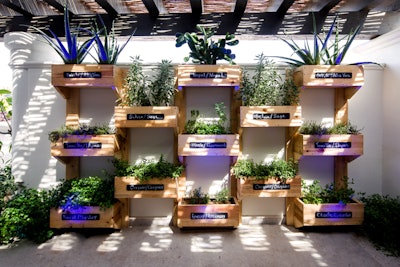 [Image: Getty Images]
[Image: Getty Images]Savvy consumers, of course, are increasingly looking to spend their hard-earned cash at places that care as much about the wellness of the Earth as they do their clientele. “As the wellness movement is growing in scope and impact, sustainability, rather than being a trend, is a long-term endeavor,” says Bonnie Baker, interim executive director of the Green Spa Network. “Spas are taking initiative in creating programming, protocols and systems with environmental virtues and placing sustainability as a core value. The result is that ‘green’ business is good business—and guests take notice.”
So, where should you start? We asked the experts at five green spas to share their eco-friendly methods when it comes to both the micro (reducing overheads) and the macro (preserving the planet).
RELATED: The Green Spa Network Set to Host Annual Buyer’s Conference
 [Image: Courtesy of Nusta Spa]
[Image: Courtesy of Nusta Spa]Jacqueline Berry, spa director, Lake Austin Spa Resort, Austin, Texas: Water conservation is important but doesn’t need to negate quality and comfort. In addition to reducing water usage, we recently added waterless and limited-water treatments to our menu, such as a scrub that can be removed while the client is on the table.
Christina Cabrera, spa director, The Spa at Westin Mission Hills, Rancho Mirage, California: We’ve taken out our wet treatment rooms and started performing body services in our massage rooms. The experience is still luxurious but saves on water. We’ve also installed Aroma Sense showerheads to reduce usage by 25 percent while enhancing the experience with an aromatherapy vitamin C cartridge. Plus we place signs in our locker rooms reminding guests that water is a precious resource.
Jayde Covenant, spa director, Alchemie Spa, Santa Monica, California: A five-step water filtration system filters hard water throughout our spa. Our tankless heater ensures water is heated based on demand, which saves energy as well as space. Low-flow fixtures reduce usage in toilet flushing, and a reverse-osmosis filtration system provides alkaline water to eliminate single-use plastic bottles.
Brad Drummer, managing owner, Nusta Spa, Washington, D.C.: Nusta is LEED Gold certified, so we go to great lengths to avoid wasting water. I recycle then filter what we’ve used throughout the day to water our plants. Our industrial washing machines are professionally calibrated so the amount of water used is based on load weight. We also reduce washings by using leftover hot/moist towels to clean surfaces.
Reducing Waste
Berry: We don’t use bottled water at the resort; instead, guests are given a reusable bottle and filtered spa water. We’ve also replaced plastic with recycled paper products, and where possible we purchase items in bulk sizes that can be decanted into reusable containers.
RELATED: The Spas at Mandarin Oriental Joins the Green Spa Network
Cabrera: We have efficient protocols that cut down on linen usage. Our cleaning system uses biodegradable detergents, and we work with vendors who have eco-friendly product packaging. We recycle more than we dispose.
Scott Kerschbaumer, cofounder and COO, ESSpa Kozmetika, Pittsburgh: We use real china, ceramics and glassware for our beverages, and plant-based disposable drop cloths and paraffin liners for treatments. We encourage guests to accept electronic receipts for their purchases to reduce paper waste.
Green Product Choices
Berry: We look for lines that use post-consumer recycled packaging and shipping materials, and partner with those whose values align with our own, such as Naturopathica, Kerstin Florian, Body Bliss and Tara Spa Therapy.
Cabrera: We have nontoxic skin- and bodycare lines that are safe for guests and the environment. Our linens are made from organic cotton, bamboo or other sustainable materials, and our spa sandals are made from recycled materials. We also have an apiary on site where we harvest our own honey for signature spa services and ‘create your own honey scrub’ bar.
RELATED: The Green Spa Network Announces Annual Sustainability Awards
Drummer: We use natural fabric softener, detergent and a nontoxic bleaching agent. Instead of chemical floor cleaners, we employ tea tree and pine oils, then every two weeks we deep clean to maintain federal standards. We’ve also created an eco-friendly environment: Recycled and custom furnishings are made with bark cloth and bamboo cloth; the two-person sauna is constructed from rapid-growth forest wood; and our carpet tiles are 52 percent post-consumer waste.
Covenant: Every product we utilize is organic. We use green laundry detergents, a nontoxic rosemary-based spray for pest control, and organic soil for our native succulent landscaping. Wall decor features cork, sea grass, recycled wood, coconut fiber and volatile organic compound (VOC)- free paints for a healthy interior environment.
Kerschbaumer: We’re committed to using sustainable, environmentally safe products throughout our facility— low-VOC and mistint paints, recycled cement and upcycled chairs, plus reclaimed flooring, lighting and decor. For daily cleaning, we use nontoxic cleaners (mostly distilled vinegar) and dye-free detergents. We incorporate essential oils into cleaning protocols and customized guest services, and strive to use locally grown produce and bulk materials from responsible suppliers.
Energy Efficiency Tips
Kerschbaumer: The biggest immediate thing spas can do to become more efficient is switch to LED light bulbs. We have almost 7,000 square feet and are open seven days a week, but our electric bill is just $300 a month since we installed LEDs. High-efficiency (HE) machines also contribute—even our HE hair dryers use almost 40 percent less energy and produce a much lower electromagnetic field.
Covenant: Our HE washers and dryers use much less water than traditional agitator washers. Nearly 80 percent of a washer’s operating cost goes to heating water, and a lower water temperature means anywhere from 20 to 50 percent less energy use. LED and natural lighting in retail areas also saves energy consumption, as do dimmer switches.
Drummer: We use the highest HEPA filter system possible, and we give our electric bill credits to eco-friendly wind/solar power companies; that’s an option for everyone who pays an electric bill.
 [Image: Courtesy of Hilton Los Cabos]
[Image: Courtesy of Hilton Los Cabos]Not every spa can stretch to beehives and alkaline water filtration systems, but any spa can go green with simple window boxes, herb carts and even vertical gardens for fresh, home-grown apothecary ingredients.
Eforea Spa at Hilton Los Cabos: In the sunny, open-air waiting room of this Mexican gem, guests are invited to hand- pick fresh herbs for their services directly from the vertical Living Wall garden.
Spa Sage at La Posada de Santa Fe Resort & Spa: Native prairie sage grows in abundance in New Mexico’s high desert, and Spa Sage greets guests with a wooden bowl of the dried herb for aromatic sachets to be burned in a purifying Native American ritual.
Alchemie Spa: A petite, drought-resistant garden welcomes guests at this Santa Monica, California-based spa, where all products are made in the U.S.—and body scrubs and herbal concoctions are prepped fresh, in house.
‘Awili Spa and Salon at Andaz Maui Wailea: This Hawaiian spa features a dedicated blending bar with oils and lotions made from fresh local herbs, fruit purées and flowers.
Lake Austin Spa Resort: This Texas destination has a dedicated director of flora and fauna who grows organic herbs—chamomile, rosemary, sage, peppermint, eucalyptus and lavender—on site for their healing properties in treatments, food and hands-on workshops.
Spa at Rancho Bernardo Inn: Guests at this lushly landscaped San Diego day spa can blend herbs for aromatic Thai poultice balls made from fresh lavender, rose hips and orange peel, among others.
– by Vicki Arkoff











